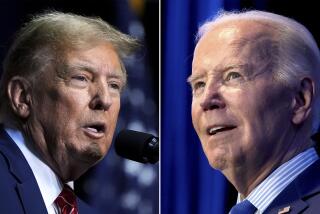Column: The Republicans’ midterm advantage: reliable voters

National polling on the Nov. 4 midterm elections confirms a doleful trend that’s been firming up all year: Voters aren’t enthusiastic about their choices — on either side.
A Gallup Poll last week found that only 32% of voters said they felt “extremely motivated” to go to the polls this year, down sharply from the 50% who were fired up for the 2010 congressional election. Democrats are less enthusiastic than Republicans, but even GOP voters say they’re less excited than they were four years ago.
Yet it’s a consequential election — control of Congress hangs in the balance, and with it a host of important issues, including healthcare, environmental regulation and immigration reform. Not that that’s the focus of much of the candidates’ advertising. They’re demonizing their opponents, working to convince voters that the other guy is intolerable — and often succeeding.
Republicans have sought to turn the election into a referendum on President Obama, especially wherever they stand a good chance of dethroning incumbent Democratic senators. Democrats have painted their GOP opponents as soldiers in a “war on women.”
Who’s winning the motivation derby? Republicans, apparently. That Gallup Poll found that 44% of voters who expected to vote Republican described themselves as “extremely motivated”; only 25% of Democratic voters felt that way. Other polls yield similar results, although most are less dramatic. “There’s no way around it: There’s a huge enthusiasm gap,” Democratic pollster Celinda Lake told me Tuesday.
That doesn’t guarantee that Republicans will win the six additional Senate seats they need to take control of both halves of Congress. But the Democrats have a core problem that goes beyond the current polls: In congressional “off year” elections, their voters don’t show up.
The numbers are stark. About 133 million people voted in the presidential elections of 2008, but only about 90 million turned up for the congressional elections of 2010 — almost one-third fewer. The no-shows included disproportionate numbers of young people, women and minority voters — all largely Democratic groups. The “reliable voters” were disproportionately elderly, white and male — all groups that tend to vote Republican.
Or look at voter participation by income. Most affluent Americans vote every two years, rain or shine; the poor — working or not — don’t vote nearly as reliably.
In 2010, 62% of voting-age citizens in households earning $250,000 or more a year turned out for the congressional election; only 35% of those earning $30,000 or less showed up.
Why don’t low-income voters turn out? After all, they often have a direct stake in government policies — including minimum wage laws, healthcare and welfare reform.
Political scientists and campaign professionals offer several explanations. In some cases, it’s more difficult for poor people to get to the polls because of work schedules and access to transportation. And low-income voters are often less engaged in general in civic activities than more affluent voters. They often say they don’t see much difference between the candidates, or that they don’t think an election’s outcome will matter.
At a series of focus groups with “low propensity voters” in Detroit this year, Lake discovered that many didn’t know what was at stake. “They didn’t know who controls the Senate,” she said. “So they didn’t realize that their state could make the difference.”
In the focus group, conducted for the liberal organization MoveOn.org, Lake said she offered a traditional argument for voting, telling participants that their friends and relatives would be turning out. “They said: Not our friends and family.”
The lesson? “It’s going to take a strong message to get those voters — single women and African American women — to turn out,” Lake said.
And according to the focus group, the message that had the greatest impact, was “equal pay for equal work.”
That’s not the core message Democrats expected to be carrying into the fall, although it was always going to be part of their campaign. Originally, the White House built a platform based a proposed increase in the federal minimum wage — and, with luck, an improving economy.
But the economy didn’t improve fast enough; many voters say it still feels as if the country’s in a recession. And the Senate never passed its proposed minimum wage increase — although Democrats still hope state minimum wage measures on the ballot in Alaska and Arkansas will help them win tight races there.
“Campaigning on an economic message is awkward when you can’t take a victory lap,” Lake conceded.
So the Democrats are left frowning at those stark numbers about who votes while Republicans can keep smiling. Perhaps the Democrats’ other angle — an ambitious $60-million “get out the vote” ground operation — will succeed in boosting their turnout to presidential-year levels in the states they need most.
But the Republicans have a much easier job — simply because their voters are more reliable.
Twitter: @DoyleMcManus
Follow the Opinion section on Twitter @latimesopinion
More to Read
A cure for the common opinion
Get thought-provoking perspectives with our weekly newsletter.
You may occasionally receive promotional content from the Los Angeles Times.







